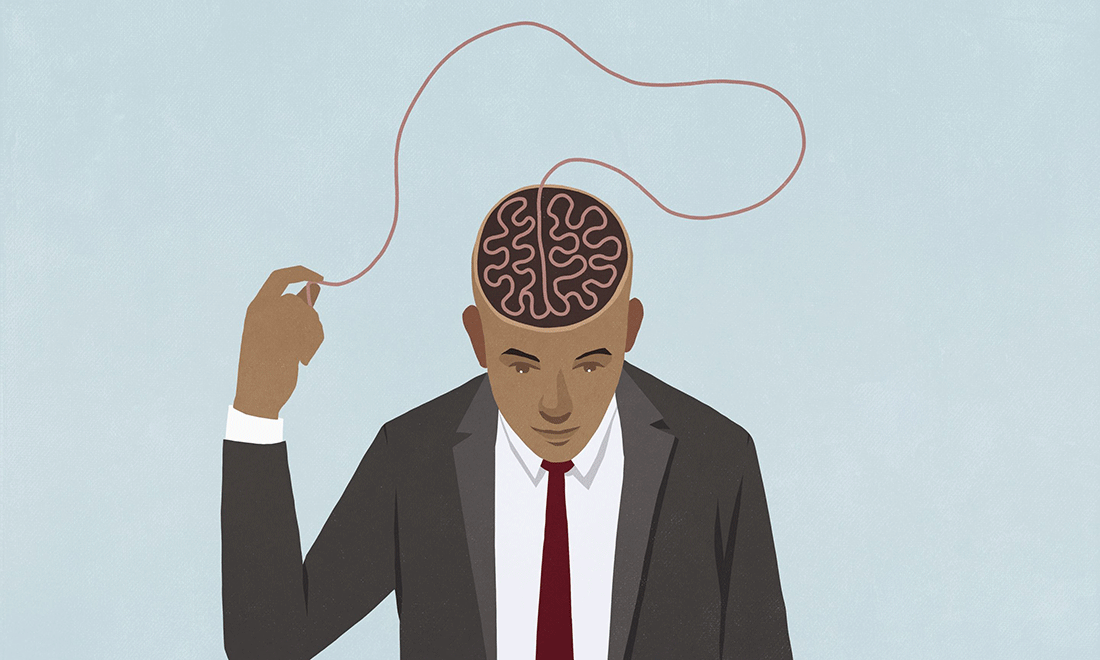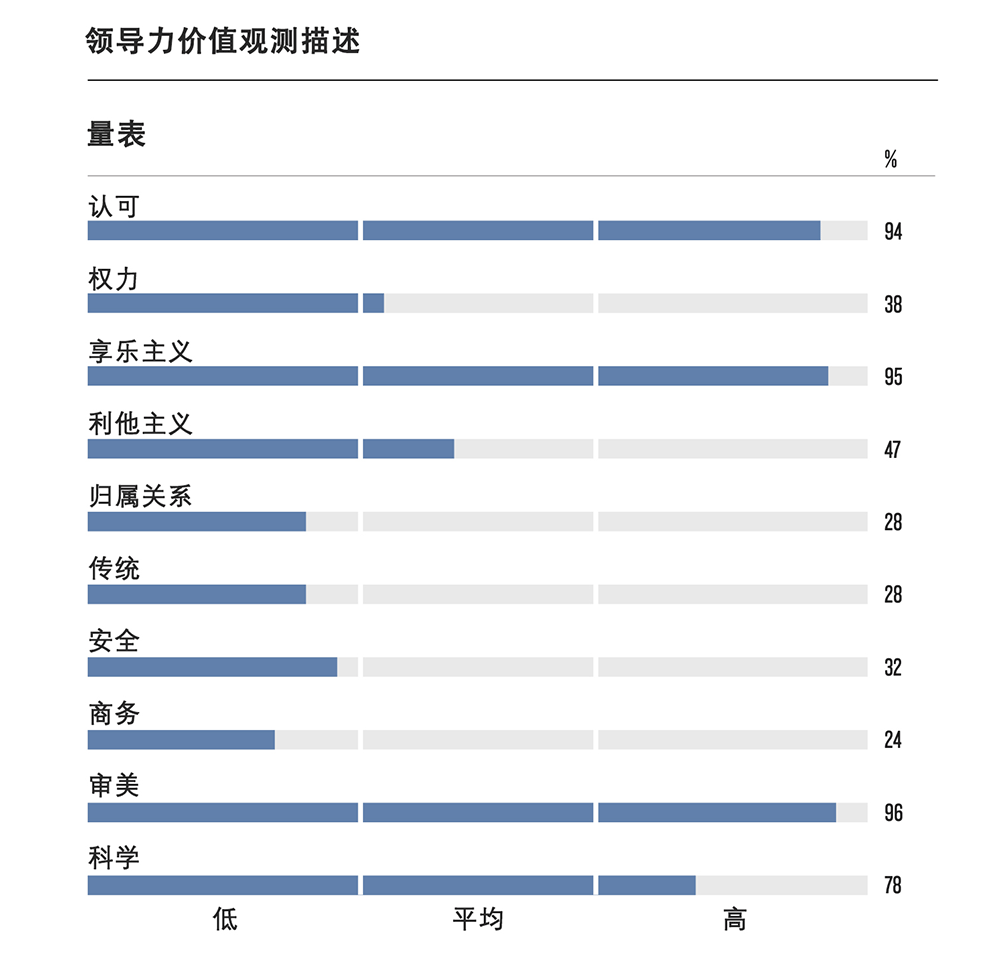
霍根測(cè)評(píng)系統(tǒng)公司(Hogan Assessment Systems)的互動(dòng)解決方案副總裁杰基·薩姆告訴我:“這可能會(huì)讓人感到不舒服,?!苯鼉蓚€(gè)半小時(shí)的線上會(huì)議已經(jīng)進(jìn)行了大約40分鐘,,會(huì)上我們分析了我上周完成的三項(xiàng)性格和發(fā)展測(cè)試的結(jié)果。
在會(huì)議結(jié)束時(shí),,薩姆將講述“特雷的故事”(正如她所講述的那樣),,就像她過去每天與那些被考慮擔(dān)任領(lǐng)導(dǎo)職務(wù)的高管們進(jìn)行一對(duì)一的會(huì)談一樣。
雖然沒有人邀請(qǐng)我擔(dān)任一家價(jià)值數(shù)十億美元的全球性企業(yè)的首席執(zhí)行官,,但這并不妨礙我偶爾有這樣的想法:“他們應(yīng)該讓我來(lái)經(jīng)營(yíng)這家公司,。”因此,我決定測(cè)試一下自己是否有能力領(lǐng)導(dǎo)一家龐大的企業(yè),。
在許多圈子里,,霍根測(cè)評(píng)被認(rèn)為是幫助各大公司和獵頭評(píng)估首席執(zhí)行官候選人是否具備掌舵所需的個(gè)性和品格的行業(yè)標(biāo)準(zhǔn)。這項(xiàng)測(cè)試是由總部位于美國(guó)俄克拉荷馬州的人力資源咨詢公司霍根測(cè)評(píng)系統(tǒng)公司在20世紀(jì)80年代開發(fā)的,,它利用數(shù)據(jù)科學(xué)與心理分析相結(jié)合的方法,,在深入的性格測(cè)試基礎(chǔ)上預(yù)測(cè)測(cè)試者的工作表現(xiàn)。海德思哲國(guó)際咨詢公司(Heidrick & Struggles)和羅盛咨詢(Russell Reynolds)等獵頭招聘公司,,以及《財(cái)富》美國(guó)500強(qiáng)公司的董事會(huì),,都將這些結(jié)果(作為一系列測(cè)評(píng)的一部分)用于繼任決策。
薩姆說(shuō):“性格測(cè)試與認(rèn)知能力或其他能力測(cè)試一樣,,都能夠預(yù)測(cè)表現(xiàn),。”
霍根測(cè)評(píng)過程(薩姆讓我經(jīng)歷的)包括三項(xiàng)測(cè)試,,進(jìn)行綜合分析后,,就可以相當(dāng)全面地了解該高管。有些高管在與高管教練合作的同時(shí),,多次參加測(cè)評(píng),,以了解自己在哪些方面需要改進(jìn),從而更好地滿足公司的領(lǐng)導(dǎo)力需求,。這一過程可能會(huì)持續(xù)數(shù)月或數(shù)年,,具體取決于繼任時(shí)間。
“它會(huì)深入到你性格和個(gè)性的方方面面,。我們認(rèn)為,,如果你輕松完成測(cè)評(píng),那么你可能就無(wú)法實(shí)現(xiàn)成長(zhǎng),;如果我們告訴你一堆你已經(jīng)知道的關(guān)于自己的特征,,讓你感覺飄飄然,那么我們就徒勞無(wú)功,?!彼_姆表示。
我完成了三項(xiàng)測(cè)評(píng),,花了一個(gè)多小時(shí),。每項(xiàng)測(cè)評(píng)的平均時(shí)間是12分鐘到15分鐘,但我承認(rèn)我花了更長(zhǎng)的時(shí)間,,因?yàn)槲以谧龉P記,,而且過度思考某些提示。
霍根測(cè)評(píng)與DiSC性格測(cè)試和邁爾斯-布里格斯類型指標(biāo)(MBTI)性格測(cè)試等其他行為測(cè)評(píng)相差無(wú)幾,。但是,,霍根測(cè)評(píng)使用的不是“是”或“否”的問題,,而是諸如“我經(jīng)常想知道我是如何走到今天這步田地的”這樣的表述,候選人能夠在“非常同意”到“非常不同意”之間進(jìn)行選擇,。
測(cè)評(píng)中的其他問題還包括:“總的來(lái)說(shuō),,我有時(shí)會(huì)對(duì)一些事情感到惱火?!薄熬痛蠖鄶?shù)事情而言,,我做得比我認(rèn)識(shí)的幾乎所有人都好?!薄拔彝P(guān)注自己犯的錯(cuò)誤,,而不是取得的成就?!薄皯{借三寸不爛之舌,,我?guī)缀蹩梢詮乃械睦Ь持薪饷摮鰜?lái)?!薄拔曳?wù)的大多數(shù)領(lǐng)導(dǎo)都缺乏領(lǐng)導(dǎo)能力,。”
例如,,MBTI性格測(cè)試把我歸類為INTJ-T型人格,,而霍根測(cè)評(píng)則將結(jié)果細(xì)分為不同的量表,比如交際,、認(rèn)可或?qū)徝?。?8個(gè)量表被細(xì)分為更詳盡的子量表,訓(xùn)練有素的心理學(xué)家用這些量表來(lái)推斷高管的性格,、領(lǐng)導(dǎo)能力和人際關(guān)系技巧,。例如,我的報(bào)告顯示我的認(rèn)可度得分很高,,這表明我往往渴望因?yàn)槌删投@得贊揚(yáng),,這種欲望能夠激勵(lì)我繼續(xù)奮勇向前,從而成為人們關(guān)注的焦點(diǎn),,并一舉成名,。

三項(xiàng)評(píng)估里的第一項(xiàng),即人格量表,,被霍根稱為“光明面測(cè)評(píng)”,。人格量表測(cè)評(píng)的是你處于最佳狀態(tài)時(shí)的表現(xiàn)——整夜安眠,沒有壓力,,精力充沛,。第二項(xiàng)是發(fā)展量表,,另外一種說(shuō)法是“陰暗面量表”,。發(fā)展量表測(cè)評(píng)的是你處于最糟糕狀態(tài)時(shí)的表現(xiàn)。最后一項(xiàng)是動(dòng)機(jī)、價(jià)值觀和偏好量表,,旨在了解你的動(dòng)力和目標(biāo),。
薩姆說(shuō),這些問題被設(shè)計(jì)得很難鉆空子,。她解釋道:“如果問題是‘我有雄心壯志:是還是否’,,那么很容易就可以看出問題設(shè)計(jì)者的意圖。但我們可能會(huì)問你這樣的問題:‘除非我比賽獲勝了,,否則我很難享受比賽過程,。’這讓我們對(duì)你的抱負(fù)有所了解,?!?/p>
我非常認(rèn)真地接受了測(cè)評(píng)。我通常不接受性格測(cè)試——盡管我的伴侶喜歡九型人格測(cè)試——但這是為了工作,,而且測(cè)評(píng)我的人的本職工作是分析首席執(zhí)行官的性格特征,。更何況,薩姆說(shuō)這種測(cè)評(píng)一般要花費(fèi)公司1,000美元左右,。
首先,,我關(guān)掉了正在播放的《紐約嬌妻》(Real Housewives of New York)。坐在沙發(fā)上,,我打開了霍根公司代表發(fā)給我的電子郵件,,里面有三項(xiàng)測(cè)評(píng)的鏈接以及我的臨時(shí)霍根測(cè)評(píng)用戶名和密碼。大多數(shù)高管也是通過線上方式來(lái)完成這些測(cè)評(píng)的,,不過我不知道他們更喜歡哪部《嬌妻》系列劇集,。薩姆說(shuō),有些測(cè)評(píng)是在有人監(jiān)督的情況下完成的,,但這種情況已經(jīng)越來(lái)越少了,。不過,為避免分心,,她建議人們?cè)谌粘瘫砩习才藕脮r(shí)間以獲得最準(zhǔn)確的結(jié)果,。我參加測(cè)試時(shí)很緊張,但這并不是因?yàn)閱栴}很難回答,。我希望我的答案盡可能誠(chéng)實(shí),,以保證新聞報(bào)道的完整性。
通常情況下,,我的做法是深入閱讀問題,,目的不是鉆空子,而是真正理解問題的設(shè)計(jì)初衷,。我是典型的多慮者,,這導(dǎo)致我預(yù)測(cè)很多問題的設(shè)計(jì)初衷,。問我“在我看來(lái),不喝酒的人不值得信賴”,,是想讓我承認(rèn)自己是個(gè)酒鬼嗎,?或是僅僅是為了測(cè)試我有多不信任他人?還是說(shuō)這道題可能是在深入研究我的社會(huì)關(guān)系,?關(guān)于我是否會(huì)成為一名有效的領(lǐng)導(dǎo)者,,這道題能夠說(shuō)明什么?
后一個(gè)問題很難回答,。
首席執(zhí)行官的工作很復(fù)雜,,除了性格之外,成功與否還受許多因素影響,。此外,,薩姆說(shuō),除了提高盈利能力和股東價(jià)值之外,,根本沒有其他很好的方法來(lái)衡量首席執(zhí)行官的業(yè)績(jī),。但她指出,在較低的層級(jí)上,,該組織擁有更可靠的數(shù)據(jù),。比如,她說(shuō),,公司的數(shù)據(jù)顯示,,根據(jù)霍根測(cè)評(píng)招聘的公交車司機(jī)發(fā)生事故的可能性降低了60%。
海德思哲國(guó)際咨詢公司首席執(zhí)行官和董事會(huì)事務(wù)合伙人特蕾莎·文森表示,,她將霍根測(cè)評(píng)視為“數(shù)據(jù)星系中的一顆恒星”,,這意味著它是眾多考慮因素中的一項(xiàng)考慮因素。
“特雷的故事”
雖然不愿承認(rèn),,但我的霍根測(cè)評(píng)準(zhǔn)確無(wú)誤,。我的愛人讀到薩姆對(duì)我的側(cè)寫時(shí)(從全局角度思考給出的側(cè)寫),甚至驚訝得倒抽了一口氣(薩姆從未見過我,,只看到了我的回答提供的圖表和數(shù)據(jù)點(diǎn)),。
薩姆告訴我:“你享受生活、尋找樂趣的愿望有時(shí)可能會(huì)因?yàn)槟阆胱寗e人了解,、發(fā)現(xiàn)和/或認(rèn)可你的成就而受到阻礙,、破壞或威脅。當(dāng)你感到壓力,、無(wú)聊,、不堪重負(fù)或筋疲力盡時(shí),你很容易退縮,、遠(yuǎn)離他人,,或者想方設(shè)法把他人從你身邊推開,。”
她繼續(xù)說(shuō)道:“這可能弄巧成拙,,因?yàn)楫?dāng)你最需要?jiǎng)e人的時(shí)候,或者當(dāng)他們需要你的時(shí)候,,你可能會(huì)退縮,。”
不出所料,,文森也看了我的測(cè)評(píng)結(jié)果,,她開玩笑地說(shuō):“沒有人會(huì)聘請(qǐng)你當(dāng)首席執(zhí)行官?!蔽业臏y(cè)評(píng)表明,,我不適合在一家企業(yè)結(jié)構(gòu)明確的成熟公司工作。根據(jù)文森和薩姆的測(cè)評(píng)分析,,我不擅長(zhǎng)與權(quán)威人士,、既定結(jié)構(gòu)、規(guī)則和程序打交道,。
雖然我不會(huì)很快接替羅伯特·艾格[迪士尼公司(Disney)]或羅茲·布魯爾[沃爾格林(Walgreens)],,但還是有一線希望的。
薩姆說(shuō):“你的量表看起來(lái)與許多初創(chuàng)企業(yè)的創(chuàng)始及兼首席執(zhí)行官并無(wú)二致,,他們挑戰(zhàn)現(xiàn)有的體制,,打破傳統(tǒng),勇于冒險(xiǎn),,開創(chuàng)了前所未有的局面,。”她警告說(shuō),,雖然這聽起來(lái)不錯(cuò),,但作為一名領(lǐng)導(dǎo)者,我很可能會(huì)對(duì)流程和程序感到厭倦,。
文森稱,,如果她是我的引路人,她就會(huì)尋找一家需要扭虧為盈的公司,,或是一家陷入困境和癱瘓,,因此需要果斷而有創(chuàng)造力的思考者的公司。但即便如此,,根據(jù)我的測(cè)評(píng),,我的性格量表表明,我可能會(huì)覺得這很有挑戰(zhàn)性,,因?yàn)槲也幌矚g繁文縟節(jié),。文森說(shuō)這很好,。她推測(cè)說(shuō):“你是一個(gè)思維較為狹隘而認(rèn)知能力較強(qiáng)的人?!?/p>
盡管測(cè)評(píng)據(jù)稱很準(zhǔn)確,,但公司只是將其作為繼任等式中的一個(gè)要素。薩姆指出,,霍根測(cè)評(píng)系統(tǒng)公司甚至不會(huì)在沒有了解來(lái)龍去脈的情況下向董事會(huì)提供原始報(bào)告,,因?yàn)樗麄兊慕Y(jié)論可能不夠全面。
這些結(jié)果可以說(shuō)明一個(gè)人可能會(huì)如何領(lǐng)導(dǎo),、激勵(lì)員工,,并與員工和其他企業(yè)利益相關(guān)者溝通和建立聯(lián)系。但文森指出:“如果想要[繼任計(jì)劃]完美無(wú)暇,,就應(yīng)該采用多管齊下的方式,。”她通過360次訪談,、模擬,、咨詢電話以及與高管長(zhǎng)達(dá)數(shù)小時(shí)的一對(duì)一會(huì)談來(lái)了解他們的工作方式。
高管選拔過程要越過層層關(guān)卡,,我只是越過了一層關(guān)卡,,結(jié)果表明我并不適合當(dāng)《財(cái)富》美國(guó)500強(qiáng)公司的首席執(zhí)行官。但如今,,判斷誰(shuí)適合擔(dān)任首席執(zhí)行官只會(huì)變得更加困難,。
薩姆說(shuō):“我們對(duì)首席執(zhí)行官的期望是不可能實(shí)現(xiàn)的。如果你看看所有這些《財(cái)富》美國(guó)500強(qiáng)公司的領(lǐng)導(dǎo)能力模型,,他們希望你魚與熊掌兼得:剛?cè)岵?jì),,對(duì)每個(gè)人都面面俱到,但違背了人類的本性,。領(lǐng)導(dǎo)者被要求達(dá)到這些不可能達(dá)到的標(biāo)準(zhǔn),,因此,大多數(shù)人都注定會(huì)一敗涂地,?!保ㄘ?cái)富中文網(wǎng))
譯者:中慧言-王芳
霍根測(cè)評(píng)系統(tǒng)公司(Hogan Assessment Systems)的互動(dòng)解決方案副總裁杰基·薩姆告訴我:“這可能會(huì)讓人感到不舒服?!苯鼉蓚€(gè)半小時(shí)的線上會(huì)議已經(jīng)進(jìn)行了大約40分鐘,,會(huì)上我們分析了我上周完成的三項(xiàng)性格和發(fā)展測(cè)試的結(jié)果。
在會(huì)議結(jié)束時(shí),,薩姆將講述“特雷的故事”(正如她所講述的那樣),,就像她過去每天與那些被考慮擔(dān)任領(lǐng)導(dǎo)職務(wù)的高管們進(jìn)行一對(duì)一的會(huì)談一樣。
雖然沒有人邀請(qǐng)我擔(dān)任一家價(jià)值數(shù)十億美元的全球性企業(yè)的首席執(zhí)行官,但這并不妨礙我偶爾有這樣的想法:“他們應(yīng)該讓我來(lái)經(jīng)營(yíng)這家公司,?!币虼耍覜Q定測(cè)試一下自己是否有能力領(lǐng)導(dǎo)一家龐大的企業(yè),。
在許多圈子里,,霍根測(cè)評(píng)被認(rèn)為是幫助各大公司和獵頭評(píng)估首席執(zhí)行官候選人是否具備掌舵所需的個(gè)性和品格的行業(yè)標(biāo)準(zhǔn)。這項(xiàng)測(cè)試是由總部位于美國(guó)俄克拉荷馬州的人力資源咨詢公司霍根測(cè)評(píng)系統(tǒng)公司在20世紀(jì)80年代開發(fā)的,,它利用數(shù)據(jù)科學(xué)與心理分析相結(jié)合的方法,,在深入的性格測(cè)試基礎(chǔ)上預(yù)測(cè)測(cè)試者的工作表現(xiàn)。海德思哲國(guó)際咨詢公司(Heidrick & Struggles)和羅盛咨詢(Russell Reynolds)等獵頭招聘公司,,以及《財(cái)富》美國(guó)500強(qiáng)公司的董事會(huì),,都將這些結(jié)果(作為一系列測(cè)評(píng)的一部分)用于繼任決策,。
薩姆說(shuō):“性格測(cè)試與認(rèn)知能力或其他能力測(cè)試一樣,,都能夠預(yù)測(cè)表現(xiàn)?!?/p>
霍根測(cè)評(píng)過程(薩姆讓我經(jīng)歷的)包括三項(xiàng)測(cè)試,,進(jìn)行綜合分析后,就可以相當(dāng)全面地了解該高管,。有些高管在與高管教練合作的同時(shí),,多次參加測(cè)評(píng),以了解自己在哪些方面需要改進(jìn),,從而更好地滿足公司的領(lǐng)導(dǎo)力需求,。這一過程可能會(huì)持續(xù)數(shù)月或數(shù)年,具體取決于繼任時(shí)間,。
“它會(huì)深入到你性格和個(gè)性的方方面面,。我們認(rèn)為,如果你輕松完成測(cè)評(píng),,那么你可能就無(wú)法實(shí)現(xiàn)成長(zhǎng),;如果我們告訴你一堆你已經(jīng)知道的關(guān)于自己的特征,讓你感覺飄飄然,,那么我們就徒勞無(wú)功,。”薩姆表示,。
我完成了三項(xiàng)測(cè)評(píng),,花了一個(gè)多小時(shí)。每項(xiàng)測(cè)評(píng)的平均時(shí)間是12分鐘到15分鐘,,但我承認(rèn)我花了更長(zhǎng)的時(shí)間,,因?yàn)槲以谧龉P記,而且過度思考某些提示,。
霍根測(cè)評(píng)與DiSC性格測(cè)試和邁爾斯-布里格斯類型指標(biāo)(MBTI)性格測(cè)試等其他行為測(cè)評(píng)相差無(wú)幾,。但是,,霍根測(cè)評(píng)使用的不是“是”或“否”的問題,而是諸如“我經(jīng)常想知道我是如何走到今天這步田地的”這樣的表述,,候選人能夠在“非常同意”到“非常不同意”之間進(jìn)行選擇,。
測(cè)評(píng)中的其他問題還包括:“總的來(lái)說(shuō),我有時(shí)會(huì)對(duì)一些事情感到惱火,?!薄熬痛蠖鄶?shù)事情而言,我做得比我認(rèn)識(shí)的幾乎所有人都好,?!薄拔彝P(guān)注自己犯的錯(cuò)誤,而不是取得的成就,?!薄皯{借三寸不爛之舌,我?guī)缀蹩梢詮乃械睦Ь持薪饷摮鰜?lái),?!薄拔曳?wù)的大多數(shù)領(lǐng)導(dǎo)都缺乏領(lǐng)導(dǎo)能力?!?/p>
例如,,MBTI性格測(cè)試把我歸類為INTJ-T型人格,而霍根測(cè)評(píng)則將結(jié)果細(xì)分為不同的量表,,比如交際,、認(rèn)可或?qū)徝馈S?8個(gè)量表被細(xì)分為更詳盡的子量表,,訓(xùn)練有素的心理學(xué)家用這些量表來(lái)推斷高管的性格,、領(lǐng)導(dǎo)能力和人際關(guān)系技巧。例如,,我的報(bào)告顯示我的認(rèn)可度得分很高,,這表明我往往渴望因?yàn)槌删投@得贊揚(yáng),這種欲望能夠激勵(lì)我繼續(xù)奮勇向前,,從而成為人們關(guān)注的焦點(diǎn),,并一舉成名。
三項(xiàng)評(píng)估里的第一項(xiàng),,即人格量表,,被霍根稱為“光明面測(cè)評(píng)”。人格量表測(cè)評(píng)的是你處于最佳狀態(tài)時(shí)的表現(xiàn)——整夜安眠,,沒有壓力,,精力充沛。第二項(xiàng)是發(fā)展量表,另外一種說(shuō)法是“陰暗面量表”,。發(fā)展量表測(cè)評(píng)的是你處于最糟糕狀態(tài)時(shí)的表現(xiàn),。最后一項(xiàng)是動(dòng)機(jī)、價(jià)值觀和偏好量表,,旨在了解你的動(dòng)力和目標(biāo),。
薩姆說(shuō),這些問題被設(shè)計(jì)得很難鉆空子,。她解釋道:“如果問題是‘我有雄心壯志:是還是否’,,那么很容易就可以看出問題設(shè)計(jì)者的意圖。但我們可能會(huì)問你這樣的問題:‘除非我比賽獲勝了,,否則我很難享受比賽過程,。’這讓我們對(duì)你的抱負(fù)有所了解,?!?/p>
我非常認(rèn)真地接受了測(cè)評(píng)。我通常不接受性格測(cè)試——盡管我的伴侶喜歡九型人格測(cè)試——但這是為了工作,,而且測(cè)評(píng)我的人的本職工作是分析首席執(zhí)行官的性格特征,。更何況,,薩姆說(shuō)這種測(cè)評(píng)一般要花費(fèi)公司1,000美元左右,。
首先,我關(guān)掉了正在播放的《紐約嬌妻》(Real Housewives of New York),。坐在沙發(fā)上,,我打開了霍根公司代表發(fā)給我的電子郵件,里面有三項(xiàng)測(cè)評(píng)的鏈接以及我的臨時(shí)霍根測(cè)評(píng)用戶名和密碼,。大多數(shù)高管也是通過線上方式來(lái)完成這些測(cè)評(píng)的,,不過我不知道他們更喜歡哪部《嬌妻》系列劇集。薩姆說(shuō),,有些測(cè)評(píng)是在有人監(jiān)督的情況下完成的,,但這種情況已經(jīng)越來(lái)越少了。不過,,為避免分心,,她建議人們?cè)谌粘瘫砩习才藕脮r(shí)間以獲得最準(zhǔn)確的結(jié)果。我參加測(cè)試時(shí)很緊張,,但這并不是因?yàn)閱栴}很難回答,。我希望我的答案盡可能誠(chéng)實(shí),以保證新聞報(bào)道的完整性,。
通常情況下,,我的做法是深入閱讀問題,目的不是鉆空子,而是真正理解問題的設(shè)計(jì)初衷,。我是典型的多慮者,,這導(dǎo)致我預(yù)測(cè)很多問題的設(shè)計(jì)初衷。問我“在我看來(lái),,不喝酒的人不值得信賴”,,是想讓我承認(rèn)自己是個(gè)酒鬼嗎?或是僅僅是為了測(cè)試我有多不信任他人,?還是說(shuō)這道題可能是在深入研究我的社會(huì)關(guān)系,?關(guān)于我是否會(huì)成為一名有效的領(lǐng)導(dǎo)者,這道題能夠說(shuō)明什么,?
后一個(gè)問題很難回答,。
首席執(zhí)行官的工作很復(fù)雜,除了性格之外,,成功與否還受許多因素影響,。此外,薩姆說(shuō),,除了提高盈利能力和股東價(jià)值之外,,根本沒有其他很好的方法來(lái)衡量首席執(zhí)行官的業(yè)績(jī)。但她指出,,在較低的層級(jí)上,,該組織擁有更可靠的數(shù)據(jù)。比如,,她說(shuō),,公司的數(shù)據(jù)顯示,根據(jù)霍根測(cè)評(píng)招聘的公交車司機(jī)發(fā)生事故的可能性降低了60%,。
海德思哲國(guó)際咨詢公司首席執(zhí)行官和董事會(huì)事務(wù)合伙人特蕾莎·文森表示,,她將霍根測(cè)評(píng)視為“數(shù)據(jù)星系中的一顆恒星”,這意味著它是眾多考慮因素中的一項(xiàng)考慮因素,。
“特雷的故事”
雖然不愿承認(rèn),,但我的霍根測(cè)評(píng)準(zhǔn)確無(wú)誤。我的愛人讀到薩姆對(duì)我的側(cè)寫時(shí)(從全局角度思考給出的側(cè)寫),,甚至驚訝得倒抽了一口氣(薩姆從未見過我,,只看到了我的回答提供的圖表和數(shù)據(jù)點(diǎn))。
薩姆告訴我:“你享受生活,、尋找樂趣的愿望有時(shí)可能會(huì)因?yàn)槟阆胱寗e人了解,、發(fā)現(xiàn)和/或認(rèn)可你的成就而受到阻礙、破壞或威脅,。當(dāng)你感到壓力,、無(wú)聊,、不堪重負(fù)或筋疲力盡時(shí),你很容易退縮,、遠(yuǎn)離他人,,或者想方設(shè)法把他人從你身邊推開?!?/p>
她繼續(xù)說(shuō)道:“這可能弄巧成拙,,因?yàn)楫?dāng)你最需要?jiǎng)e人的時(shí)候,或者當(dāng)他們需要你的時(shí)候,,你可能會(huì)退縮,。”
不出所料,,文森也看了我的測(cè)評(píng)結(jié)果,,她開玩笑地說(shuō):“沒有人會(huì)聘請(qǐng)你當(dāng)首席執(zhí)行官?!蔽业臏y(cè)評(píng)表明,,我不適合在一家企業(yè)結(jié)構(gòu)明確的成熟公司工作。根據(jù)文森和薩姆的測(cè)評(píng)分析,,我不擅長(zhǎng)與權(quán)威人士,、既定結(jié)構(gòu)、規(guī)則和程序打交道,。
雖然我不會(huì)很快接替羅伯特·艾格[迪士尼公司(Disney)]或羅茲·布魯爾[沃爾格林(Walgreens)],,但還是有一線希望的。
薩姆說(shuō):“你的量表看起來(lái)與許多初創(chuàng)企業(yè)的創(chuàng)始及兼首席執(zhí)行官并無(wú)二致,,他們挑戰(zhàn)現(xiàn)有的體制,,打破傳統(tǒng),,勇于冒險(xiǎn),,開創(chuàng)了前所未有的局面?!彼嬲f(shuō),,雖然這聽起來(lái)不錯(cuò),但作為一名領(lǐng)導(dǎo)者,,我很可能會(huì)對(duì)流程和程序感到厭倦,。
文森稱,如果她是我的引路人,,她就會(huì)尋找一家需要扭虧為盈的公司,,或是一家陷入困境和癱瘓,因此需要果斷而有創(chuàng)造力的思考者的公司,。但即便如此,,根據(jù)我的測(cè)評(píng),,我的性格量表表明,我可能會(huì)覺得這很有挑戰(zhàn)性,,因?yàn)槲也幌矚g繁文縟節(jié),。文森說(shuō)這很好。她推測(cè)說(shuō):“你是一個(gè)思維較為狹隘而認(rèn)知能力較強(qiáng)的人,?!?/p>
盡管測(cè)評(píng)據(jù)稱很準(zhǔn)確,但公司只是將其作為繼任等式中的一個(gè)要素,。薩姆指出,,霍根測(cè)評(píng)系統(tǒng)公司甚至不會(huì)在沒有了解來(lái)龍去脈的情況下向董事會(huì)提供原始報(bào)告,因?yàn)樗麄兊慕Y(jié)論可能不夠全面,。
這些結(jié)果可以說(shuō)明一個(gè)人可能會(huì)如何領(lǐng)導(dǎo),、激勵(lì)員工,并與員工和其他企業(yè)利益相關(guān)者溝通和建立聯(lián)系,。但文森指出:“如果想要[繼任計(jì)劃]完美無(wú)暇,,就應(yīng)該采用多管齊下的方式?!彼ㄟ^360次訪談,、模擬、咨詢電話以及與高管長(zhǎng)達(dá)數(shù)小時(shí)的一對(duì)一會(huì)談來(lái)了解他們的工作方式,。
高管選拔過程要越過層層關(guān)卡,,我只是越過了一層關(guān)卡,結(jié)果表明我并不適合當(dāng)《財(cái)富》美國(guó)500強(qiáng)公司的首席執(zhí)行官,。但如今,,判斷誰(shuí)適合擔(dān)任首席執(zhí)行官只會(huì)變得更加困難。
薩姆說(shuō):“我們對(duì)首席執(zhí)行官的期望是不可能實(shí)現(xiàn)的,。如果你看看所有這些《財(cái)富》美國(guó)500強(qiáng)公司的領(lǐng)導(dǎo)能力模型,,他們希望你魚與熊掌兼得:剛?cè)岵?jì),對(duì)每個(gè)人都面面俱到,,但違背了人類的本性,。領(lǐng)導(dǎo)者被要求達(dá)到這些不可能達(dá)到的標(biāo)準(zhǔn),因此,,大多數(shù)人都注定會(huì)一敗涂地,。”(財(cái)富中文網(wǎng))
譯者:中慧言-王芳
“It may get uncomfortable,” Jackie Sahm, vice president of interactive solutions at Hogan Assessment Systems, tells me. We’re roughly 40 minutes into our nearly two-and-a-half-hour virtual meeting analyzing the results of three personality and development assessments I completed the previous week.
At the end of the session, Sahm will recount “the story of Trey,” as she puts it, just as she used to when her day-to-day consisted of conducting one-on-one meetings with senior executives being considered for the corner office.
While no one’s asking me to be CEO of a global multi-billion dollar business operation, that hasn’t stopped me from thinking once or twice: “They should just let me run the company.” So, I decided to test whether I have what it takes to lead a sprawling organization.
In many circles, Hogan Assessments is considered the industry standard in helping companies and executive search firms assess whether a CEO candidate has the right personality and character to take the helm. The test, developed in the ’80s by the Oklahoma-based HR consulting firm Hogan Assessment Systems, uses data science paired with psychoanalysis to predict job performance based on in-depth personality assessments. Executive recruiting firms, such as Heidrick & Struggles and Russell Reynolds, and boards at Fortune 500 companies use the results in succession decisions as part of a web of assessments, as I’ve previously reported.
“Personality predicts performance just as well as cognitive ability or other abilities tests,” Sahm says.
Hogan’s assessment process—the one Sahm put me through—includes three tests that, when analyzed together, paint a fairly thorough picture of an executive. Some executives take the assessments multiple times while working with executive coaches to learn where they need to improve to best meet the company’s leadership needs. That process may take place over months or years, depending on the timing for succession.
“It gets into the crevices, the nooks and crannies of your character and personality. We think if you’re not uncomfortable, you’re probably not growing, and if we tell you a bunch of things you already knew about yourself that make you feel really good, we’ve not really done our job,” Sahm says.
I completed the three assessments, which took me just over one hour. The average is 12 to 15 minutes per assessment, but I admittedly took longer because I was jotting down notes and overthinking some of the prompts.
Hogan’s assessments are not too dissimilar to other behavioral assessments, like DiSC and Myers Briggs. But rather than yes or no questions, Hogan’s tests use statements such as, “I often wonder how I got to be the way I am,” to which candidates select a range spanning “strongly agree” to “strongly disagree.”
Other inquiries featured on the assessment include: “I sometimes get annoyed at things in general.” “I do most things better than almost everyone I know.” “I tend to focus on my mistakes more than my successes.” “I can talk my way out of almost anything.” “Most of the people I’ve worked for are incompetent.”
For example, Myers Briggs casts me as an INTJ-T, whereas Hogan breaks down results into different scales like sociability, recognition, or aesthetics. There are 28 scales broken down into more detailed subscales trained psychologists use to make inferences about executives’ personalities, leadership capabilities, and relational skills. My report, for instance, shows a high recognition score, suggesting that I tend to be motivated by a desire to be praised and celebrated for my accomplishments, be in the spotlight, and become famous.
The first of the three assessments, the personality inventory, is what Hogan calls the bright side assessment. It measures who you are when you’re at your best—after a full night’s sleep, stress-free, and firing on all cylinders. The second is a development survey, or, ominously put, the dark side profile. It measures who you are at your worst. Last is the motives, values, and preferences inventory, which seeks to capture what impels you and your purpose.
Sahm says the questions are designed to be difficult to game. “If the question says, ‘I am ambitious: true or false,’ it’s pretty easy to tell what we’re trying to get at,” she explains. “But we may ask you a question like, ‘It’s hard for me to enjoy a game unless I win.’ That gives us some insight into your ambition.”
I took the assessment incredibly seriously. I don’t typically subscribe to personality tests—though my partner loves an enneagram—but this was for work, and I would be assessed by someone whose job it is to analyze CEO personality profiles. Not to mention, Sahm says the assessment typically runs companies around $1,000.
First, I turned off the Real Housewives of New York episode playing in the background. From my couch, I opened the email a Hogan representative sent me with a link to my three assessments and my temporary Hogan ID and password. Most executives also complete these tests virtually, though I can’t say which Real Housewives series they prefer. Some tests are done in a supervised setting, but it’s become rarer, Sahm says. However, she advises people to block time on their calendars to avoid distractions and get the most accurate results. I was nervous about taking the test, though, not because the questions were tough. I wanted my answers to be as honest as possible, for journalistic integrity.
Typically, my MO is to read deep into questions, not to game the system, but to truly understand what it’s asking. I’m your classic overthinker, which led to second-guessing more than a few questions. Was asking me whether, “In my view, a person who doesn’t drink can’t be trusted,” trying to get me to admit to being a lush? Was it simply about how skeptical I am of people? Or was it possibly digging into my social interactions? And what would that say about whether I’d be an effective leader?
The latter question is tough to answer.
The CEO job is complex, with many factors beyond personality contributing to success. Plus, there simply aren’t great measures of a CEO’s performance outside of driving profitability and shareholder value, Sahm says. But at lower levels, she notes, the organization has more robust data. For example, she says the firm can point to data showing that bus drivers hired using Hogan are 60% less likely to have an accident.”
Teraesa Vinson, a partner at Heidrick & Struggles’ CEO and board of directors practice, says she uses Hogan assessments as “a star in a data galaxy,” meaning it’s one factor among many considerations.
The “story of Trey”
I hate to admit it, but my Hogan assessment was spot on. My partner even gasped reading the 30,000-foot view Sahm wrote, having never met me and with just the graphs and data points my answers provided.
“Your desire to enjoy and find pleasure in life may be thwarted, undermined, or threatened at times by a desire to be known, visible, and/or recognized for your achievements,” Sahm tells me. “When you are stressed, bored, overwhelmed, or otherwise depleted, you are prone to withdraw and move away from others or find ways to push them away from you.”
She continues: “This can be a self-defeating pattern, as you may retreat from others when you need them most—or when they need you.”
Unsurprisingly, “nobody should hire you to be their CEO,” says Vinson, who also looked at my assessment results, in jest. My assessment suggests I’m not a good fit for a mature company with a well-defined corporate structure. I don’t do well with authority, set constructs, rules, and procedures, according to Vinson and Sahm’s assessment analysis.
Although I won’t be succeeding Bob Iger at Disney or Roz Brewer at Walgreens anytime soon, there is a silver lining.
“Your profile looks not unlike many startup founder-CEOs’ where they challenged the establishment, broke from tradition, did something risky, and created something that didn’t exist before,” Sahm says. While that sounds nice enough, as a leader, I’d likely get bored with processes and procedures, she warns.
Vinson says, were she advising me, she’d look for a company that needs a turnaround or a distressed, paralyzed organization that could use a decisive and creative thinker. But even then, my personality profile suggests I might find it challenging because I don’t care to get bogged down with details, per my assessment. Vinson says that’s fine. “You’re someone who thinks more zoomed out and is cognitively facile,” she surmises.
Despite the assessment’s purported accuracy, companies use it as just one element of the succession equation. Sahm says Hogan doesn’t even give boards the raw reports without context because their takeaways might not provide the full picture.
The results are an indication of how someone might lead, engage with, inspire, and communicate with their employees and other corporate stakeholders. But Vinson notes that “if you’re doing [succession planning] right, it should be a multimodal approach.” She uses 360 interviews, simulations, reference calls, and hours worth of one-on-ones with executives to understand how they tick.
I jumped through one hoop in the C-suite selection process, and the results indicate I’m not Fortune 500 CEO material. But these days, discerning who is fit to be CEO has only gotten harder.
“We expect impossible things from CEOs. If you look at leadership competency models at all these Fortune 500 companies, they want you to be tall and short at the same time,” Sahm says. “They want you to be hard and soft; they want you to be everything to everyone, and that’s not how people are made. Leaders are held to these impossible standards, and most are set up to fail.”






